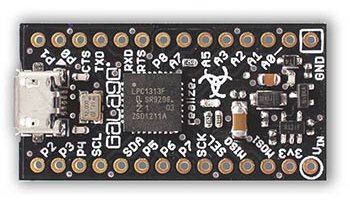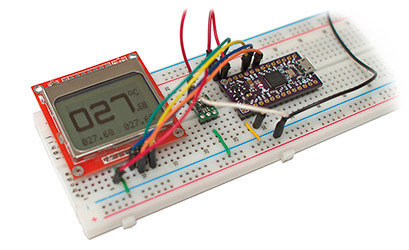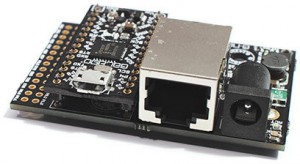Outbreak Galago is a tiny development kit based on a Cortex M3 processor that fits a debugger, and is destined for rapid electronics prototyping. The company promotes it as some sort of Arduino board on steroid (MCU wise) and sells for $25 on kickstarter, and less than $10 in 10k quantities.

Here are the board specifications:
- 72 MHz 32-bit ARM CPU with 32KB of flash ROM and 8KB of RAM (NXP LPC1313 TBC)
- Integrated hardware debugger
- One high-speed SPI port, up to 36 Mbps
- One high-speed I2C port, up to 1.5 Mbps
- One UART/USART with hardware flow-control capability, up to 256 kbps
- 10 high-speed PWM pins, 6 driven by 32-bit (high-resolution) timers
- 6 ADC (analog) input pins with 10-bit resolution at over 400 KSa/sec
- 25 GPIO (digital) input/output pins
The form factor and built-in debugger (via USB) are not really new, as those are already featured in devkit such as TI Piccolo controlSTICK, but you’ll notice the through holes that allow you to connect the board to a breadboard, add some off-the-shelf components and do some cool projects like this:

The board can be programmed in C, C++ or Wiring code with Galago’s development environment and the binary can be deployed to the hardware with a single click. The integrated debugger can be used to pause code execution, inspect variables and continue running… in order to ease debugging and find problems faster.
Outbreak also plans to provide “App Boards” for the Galago in a similar fashion to the Arduino Shield:

- Ethernet: Features a single 10Mbit Ethernet port, a micro-SD slot and an on-board power supply with barrel jack for plugged-in power.
- Audio: Features a class-D audio amplifier intended to drive an external 8-ohm speaker and a micro-SD slot.
- LEDs: Designed to drive 16 channels of PWM-controlled LEDs or similar using the TLC5940 chip. Can be daisy-chained to more ‘5940s to power large-format video displays. Comes with 64 high-brightness 5mm LEDs – 16 each red, green, blue and white.
If you want one of the app boards and the galago board, it costs $55 on kickstarter.
A “Starter Kit” is also available as part of the kick starter campaign and includes the following:
- One solderless breadboard
- One audio amplifier break-out board with headphone jack
- A serial-in, parallel-out shift register (74HC595)
- Light sensor
- Temperature sensor
- Two buttons
- A dozen jumper wires
- 8 LEDs, 10 resistors and 10 capacitors
Watch the video below for a presentation of the Galago board and Ethernet app board.
Contrary to many other kickstarter projects, this project appears near completion and they mainly need the funds for manufacturing, and pledgers should have their hardware shipped in November 2012. You can find more info on Kickstarter and/or Outbreak Galago page.

Jean-Luc started CNX Software in 2010 as a part-time endeavor, before quitting his job as a software engineering manager, and starting to write daily news, and reviews full time later in 2011.
Support CNX Software! Donate via cryptocurrencies, become a Patron on Patreon, or purchase goods on Amazon or Aliexpress





Hi, how much energy take it? Thanks
@pepe
That’s the answer on their kickstarter page:
The datasheet for the ARM chip we use (www.nxp.com/documents/data_sheet/LPC1311_13_42_43.pdf) has a table of power consumption by chip feature across a few operating frequencies on page 76. Galago’s debugger chip uses 20mA when connected to USB and 0.2uA when disconnected. The on-board power supply has an end-to-end dropout voltage of about 250mV at 30mA, with a limit at 300mA.
I am sure they are just example pictures, put they would probably work better with the headers soldered!
(seriously) Thank you for all the good info you share.
@Jean-Luc Aufranc (CNXSoft)
Thanks for the answer, but my question was about the Watts/h?
I had tryed to calculate and its impossible for me, anybody can i help me?
30 mA and 250 mV = ? Wh
Isn’t it 7.5mW (=0.030mA*.25mV)?
So .0075W/h…
@Onebir
Thanks, then this chip almost doesnt need energy for work? Right?
Maple (and mini / bacon maple) have already done this (with open source bootloader and compatible arduino libmaple).